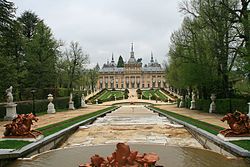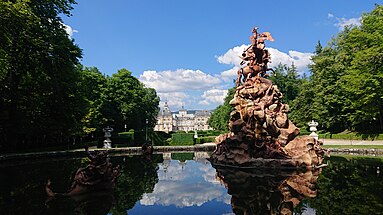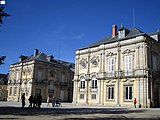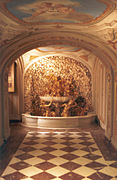
Aranjuez is a city and municipality of Spain, part of the Community of Madrid.
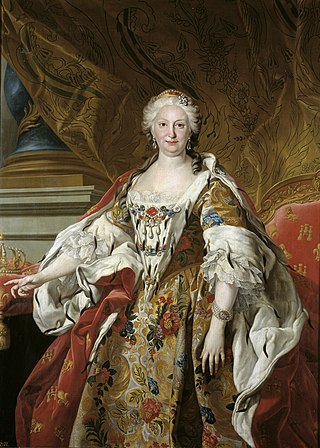
Elisabeth Farnese was Queen of Spain by marriage to King Philip V. She was the de facto ruler of Spain from 1714 until 1746 since she managed the affairs of state with the approval of her spouse, and is particularly known for her great influence over Spain's foreign policy. From 1759 until 1760, she governed as regent.

The Royal Palace of Madrid is the official residence of the Spanish royal family at the city of Madrid, although now used only for state ceremonies. The palace has 135,000 m2 (1,450,000 sq ft) of floor space and contains 3,418 rooms. It is the largest royal palace in Europe.

The Royal Sites are a set of palaces, monasteries, and convents built for and under the patronage of the Spanish monarchy. They are administered by Patrimonio Nacional (National Heritage), a Spanish state agency; most are open to the public, at least in part, except when they are needed for state or official events.

The Royal Palace of Aranjuez is one of the official residences of the Spanish royal family. It is located in the town of Aranjuez (Madrid), Spain. Established in the 16th century as a royal hunting lodge, the palace was built by order of Philip II. Under his reign it became one of four seasonal seats of the court along Rascafría, El Escorial and the Royal Alcázar of Madrid. The royal estate comprises a set of landscaped and ornate gardens and woodlands that house an extensive botanical collection.

San Ildefonso, La Granja, or La Granja de San Ildefonso, is a town and municipality in the Province of Segovia, in the Castile and León autonomous region of central Spain.

The Royal Palace of Riofrío is one of the residences of the Spanish royal family. It is under the management of Patrimonio Nacional, a government agency dedicated to the care and maintenance of properties owned by the Spanish state which the royal family uses. The building is set in a wooded deer-park in the municipality of San Ildefonso, in the province of Segovia, central Spain.

Spanish Baroque is a strand of Baroque architecture that evolved in Spain, its provinces, and former colonies.

Robert de Cotte was a French architect-administrator, under whose design control of the royal buildings of France from 1699, the earliest notes presaging the Rococo style were introduced. First a pupil of Jules Hardouin-Mansart, he later became his brother-in-law and his collaborator. After Hardouin-Mansart's death, de Cotte completed his unfinished projects, notably the royal chapel at Versailles and the Grand Trianon.

Patrimonio Nacional is a Spanish autonomous agency, under the jurisdiction of the Ministry of the Presidency, Justice and Relations with the Cortes, that administers the sites owned by the Spanish State and used by the Monarch and the Spanish Royal Family as residences and for State Ceremonies. The Patrimonio Nacional includes palaces, gardens, monasteries and convents, called the Royal sites. When not in official use, the Royal sites are open to the public. It also manages the official and holiday residences of the Prime Minister.
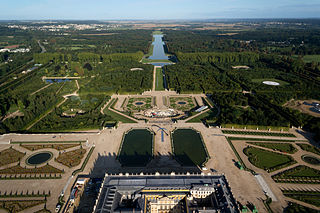
The French formal garden, also called the jardin à la française, is a style of "landscape" garden based on symmetry and the principle of imposing order on nature. Its epitome is generally considered to be the Gardens of Versailles designed during the 17th century by the landscape architect André Le Nôtre for Louis XIV and widely copied by other European courts.

Teodoro de Ardemans or Ardmans was a Spanish architect and painter.
The Royal Household and Heritage of the Crown of Spain was the institution of the Monarchy of Spain. It governed the organization of the Royal Spanish Court from the time of the Habsburg dynasty, which introduced the so-called Burgundian etiquette, up to the reign of King Alfonso XIII, great-grandfather of the current King Felipe VI, in all that regarded the structure of the Court as well as the ceremonial matters, etiquette and protocol.

The Baroque garden was a style of garden based upon symmetry and the principle of imposing order on nature. The style originated in the late-16th century in Italy, in the gardens of the Vatican and the Villa Borghese gardens in Rome and in the gardens of the Villa d'Este in Tivoli, and then spread to France, where it became known as the jardin à la française or French formal garden. The grandest example is found in the Gardens of Versailles designed during the 17th century by the landscape architect André Le Nôtre for Louis XIV. In the 18th century, in imitation of Versailles, very ornate Baroque gardens were built in other parts of Europe, including Germany, Austria, Spain, and in Saint Petersburg, Russia. In the mid-18th century the style was replaced by the less geometric and more natural English landscape garden.

The Spanish Rococo style of the 18th century is relatively unexplored and bears little resemblance to its French equivalent. Under the reign of Philip V of the Bourbon Dynasty, architectural commissions were primarily awarded to Italian architects, rather than the French who were the pioneers of the rococo style. This is largely due to the influence of his second wife, Elisabeth Farnese of Parma, who aimed to transcend French influence through the promotion of the Italians. Consequently, Rococo was left to be discovered by the Spanish school and therefore evolved separately from French and other variations of Rococo.

Valsaín is a hamlet of Real Sitio de San Ildefonso, which is a town and municipality located within the Province of Segovia in Castile and León. It is located in the foothills of the Sierra de Guadarrama mountains, 14 kilometres (8.7 mi) from Segovia, and 75 kilometres (47 mi) north of Madrid. The village had a population of 176 inhabitants in 2016.
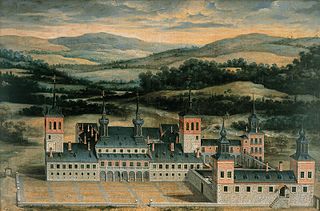
The Royal Palace of Valsain is a former Spanish royal residence, which is now in ruins. It is located in Valsain in the Province of Segovia, in the Castile and León Autonomous region of central Spain. It is approximately 14 kilometres (8.7 mi) from Segovia, and 75 kilometres (47 mi) north of Madrid.

The Ford or Landscape with Shepherds is a 1644 oil-on-canvas painting by the French artist Claude Lorrain, now in the Prado Museum, in Madrid.
Domingo Valentín Guerra Arteaga y Leiva was an 18th-century Catholic Archbishop, the queen's confessor and the Bishop of Segovia in Spain.

The Christ Child and the Infant John the Baptist with a Shell or The Holy Children with a Shell is a 1670-1675 oil on canvas painting by Bartolomé Esteban Murillo, now in the Prado Museum in Madrid.
